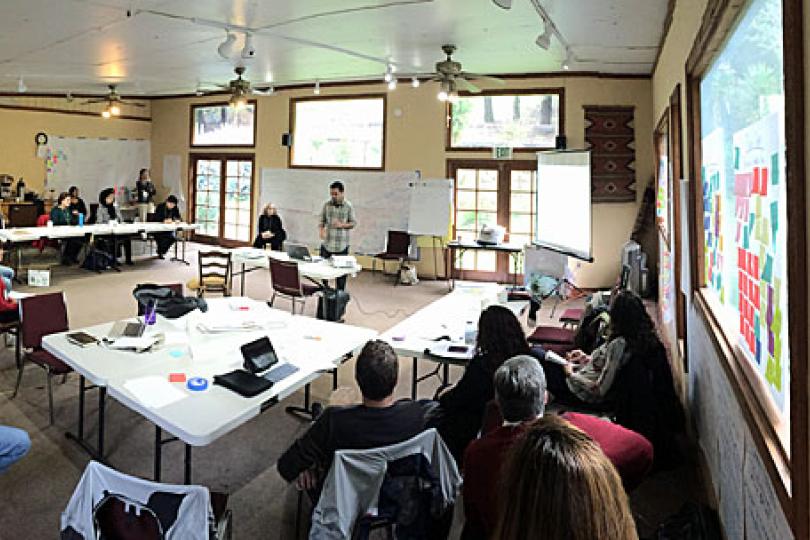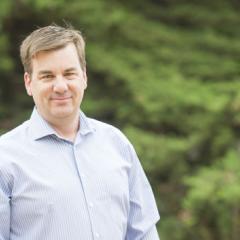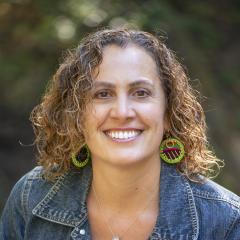Disadvantaged Communities Visioning Workshop
by Mike Antos and Carolina Balazs
It was a dark and stormy night on December 2nd, 2014, in Calistoga, California. Three years into California’s severe drought the rain seemed like providence. We were there as two members of the planning team that convened thirty water, environmental justice and water agency leaders for a three-day workshop. We had gathered the group to develop recommendations for how California’s Integrated Regional Water Management (IRWM) program could better address the needs of those living and working in disadvantaged communities* throughout the state. As two Switzer Fellows, having first met at the Spring 2014 training, this convening was the result of a natural and fast-paced partnership.
Across the prosperous state of California, and out of view of most Californians and policy makers, exists a stark reality. From the Northern Coast to the Southern deserts, from the fertile Valleys to the (decreasingly) snowy Sierras, communities struggle to achieve clean, safe and affordable water in their taps and streams. These communities are often economically disadvantaged and disenfranchised from general water governance due to cultural, geographic and historical patterns of isolation and exclusion. In the vast urban centers of the San Francisco Bay Area, Los Angeles and San Diego, members of disadvantaged communities do have safe drinking water (with some exceptions) and sanitation, but lack green space, suffer from localized flooding, and are subjected to poor surface water quality due to dry- and wet-weather runoff contamination.
From 2011-2015, the California Department of Water Resources funded seven pilot projects (in which both of us were involved, Carolina in Kings County and Mike in Los Angeles) to develop models that could identify how better to represent the needs and engage the people of disadvantaged communities in the IRWM process. The gathering in Calistoga brought together the teams that worked on these seven projects to achieve consensus about lessons learned, and next-steps.
As we forged relationships and built group trust in Calistoga, we collectively developed eight inter-locking recommendations that reflect a common understanding of the changes needed to make IRWM work for the people living in disadvantaged communities. On our final day, leaders of Department of Water Resources and the State Water Resources Control Board gathered to hear these recommendations and provide input. This was novel—we brought together those on the ground and the agencies to develop a shared vision.
Since the event, the recommendations have been circulated to the Department of Water Resources, and shared broadly by water leaders. Members of our planning team are developing advocacy campaigns to push for new legislation based on these recommendations (and in fact three proposed bills speak to our conclusions). With the passing of the Human Right to Water in California in 2012 (Assembly Bill 685), California is in an historic moment—the political will exists to address the water needs of Californians living and working in disadvantaged communities by developing sustainable and equitable long-term solutions. The pilot projects and the December workshop developed the knowledge and information necessary to assure members of disadvantaged communities are engaged by and with water governance, yielding increased capacity within the community and improved water conditions.
As Switzer Fellows, we are grateful for the support provided by the Foundation through a Network Innovations Grant that is allowing us to further our professional work, and keep growing as individuals and leaders. In the last year, two moments had shaped our recent collaboration on water. The first was last spring’s 2014 training in San Francisco. There, the topic was on Collective Leadership. At that event, we discussed and learned the multiple types of leadership models, and how we can often lead groups from behind, or in collectivity, not just with a sole leader. Little did we know we would soon be collaborating together on real-time collective leadership! Following last summer’s American Water Resources Association conference where we each presented our work with disadvantaged communities and Integrated Regional Water Management, we decided we needed to meet for further reflection, in a Switzer-style space that offers a place for dialogue and the generation of creative solutions.
Today we are left feeling very hopeful. The conditions are ripe. California has a thriving network of community residents and leaders, disadvantaged community representatives or engaged organizations, government agencies and researchers. A tapestry of new propositions and laws governing water are being considered by the legislature, or has been passed by California voters. With the support of the Foundation we were able to harness collective will, knowledge and vision. While there is clearly a long way to go in California, we feel both proud and fortunate to have helped lead this important moment. Greater equity in the provision of safe, clean and affordable water, and in the distribution of state funding, are both advancing in a very hopeful way.
*For context, a “disadvantaged community” is described in California law as a community where the median household income is below 80% of the statewide median household income. This classification encompasses one third of the state’s population, about 12 million people. While the state has shifted towards a regionally cooperative form of water governance, Integrated Regional Water Management, many of these communities have struggled to engage with this process, and with accessing the funding available through such programs.


